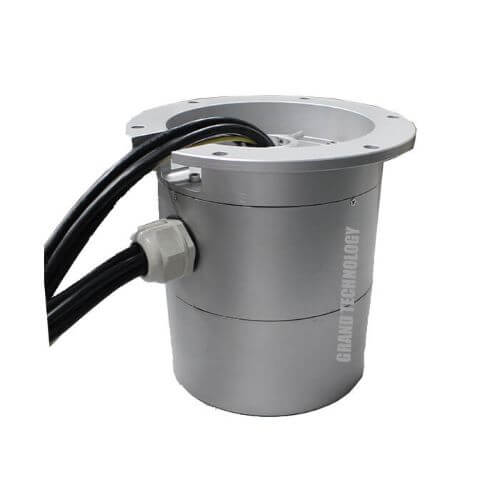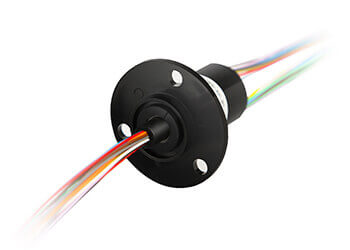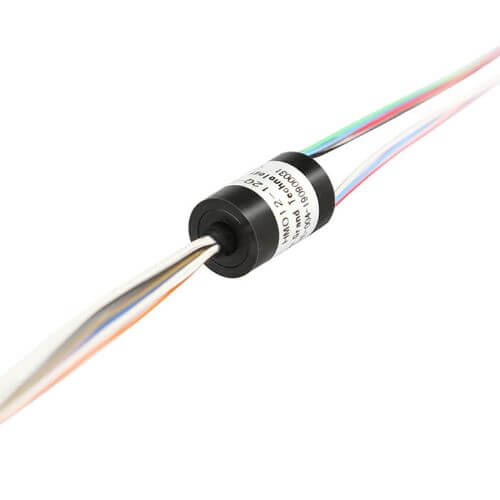Slip rings, also known as rotary electrical connectors, are devices that allow electrical power or signals to be transmitted from a stationary source to a rotating component or vice versa. They play an essential role in eliminating the issue of tangling wires while facilitating smooth electrical connections and reliable data transmission. Typically, slip rings have a rotating part, consisting of a conductive ring, and a stationary part made up of brushes that make contact with the moving ring, ensuring a continuous electrical connection.
The 8 wire slip ring is a specialized variation designed to meet the increasing demand for simultaneous transmission of multiple signals and power sources – particularly in complex applications. As the name implies, it has eight separate conductive paths, each capable of delivering power, signals, or both. The individual wires can be tailored to handle different current ratings, catering to a system’s specific requirements. The versatile nature of the 8 wire slip ring has resulted in it becoming a highly sought-after component for a wide array of industries, ranging from renewable energy and automation to medical equipment and aerospace engineering.
8 Wire Slip Ring Design and Structure
Design of an 8 Wire Slip Ring
The design of an 8 wire slip ring consists of a central rotating component, usually a rotor, with conductive rings positioned concentrically around it. While the rotor spins, the stationary brushes maintain contact with each of the eight conductive rings. Precisely engineered housing encases the entire assembly, protecting the environment while ensuring proper assembly and alignment of both stationary and rotating parts.
The brushes are typically made from materials like carbon, copper, or silver, which offer high conductivity and minimal wear over time. The rotating conductive rings may be made from metals like gold or copper, given their excellent conductivity and long-lasting performance. Additionally, the insulating layer between the conductive rings is carefully chosen to minimize electrical interference and to ensure optimal heat dissipation.
Implementation of the 8 Wires
The 8 wires used in a slip ring are meticulously implemented in tandem with the design to meet the application’s requirements. Each wire is connected to its respective brush and conductive ring combination, allowing for independent signal or power transmission. The specific roles of the 8 wires may vary depending on the needs of the application:
- Some wires may solely transmit power at various voltage levels or currents for different components.
- Other wires may handle communication signals, such as data, video, or control signals, ensuring uninterrupted data transfer between stationary and rotating parts.
- In certain instances, the wires may be configured to carry both power and communication signals, depending on the requirements of the system.

Adjusting the size and materials used for each wire allows for control over the current-carrying capacity and signal integrity. The design of the 8 wire slip ring ensures their proper positioning and compatibility with other components in the larger system. By carefully considering factors such as wire diameter, insulation, and routing, engineers effectively design these slip rings to accommodate the full range of application-specific electrical and operational requirements, leading to enhanced performance and reliability for the end-user.

8 Wire Slip Ring Working Principle
Operation of an 8 Wire Slip Ring
The operation of an 8 wire slip ring revolves around the uninterrupted transfer of power and signals between the stationary and rotating parts of a system. These components need constant connectivity to work together seamlessly, and the slip ring’s design ensures this through constant contact between the brushes and conductive rings.
As the rotor spins and the conductive rings rotate along with it, the brushes maintain an electrical connection by sliding over the surface of each conductive ring. The brushes transmit power or signals from the stationary wires to the rotating rings or vice versa, depending on the system’s configuration, without causing any tangling of wires or disruption in transmission.
The 8 wire slip ring differentiates itself from other slip ring configurations by having eight distinct conductive pathways. Each of these pathways is designated for the transmission of specific power levels, signals, or a combination of both, as dictated by the requirements of the application.
Roles of Key Components in 8 Wire Slip Ring
- Bearings: Bearings systems are crucial to the smooth rotation of the slip ring assembly. They support the rotor and help minimize friction, enabling the conductive rings to rotate freely alongside the moving parts of the system. High-quality bearings are paramount in ensuring long-lasting operation and reducing wear on both rotating and stationary components.
- Brushes: Brushes establish the electrical connection between the stationary wires and the moving conductive rings. Owing to their material composition, they offer low contact resistance and minimal wear while sliding over the conductive rings. The proper size, material, and placement of brushes are critical to maintaining reliable electrical transmission and minimizing potential disruptions in communication or power flow.
- Rotor: The rotor is a central component that holds the conductive rings and facilitates their rotation. It is crafted from robust materials to withstand the torque exerted by the rotating machinery while maintaining concentricity and alignment of the conductive rings. The rotor’s design ensures proper functioning and a level of durability necessary for enduring the demands placed on it during operation.
- Conductive Rings: Conductive rings are an essential part of the slip ring, providing the pathways for power and signal transfer. They are made from materials such as gold or copper that offer excellent electrical conductivity and resistance to wear. Their concentric arrangement around the rotor allows multiple electrical contacts to be maintained simultaneously for each of the eight independent circuits.
The harmonious interplay of these critical components empowers the 8 wire slip ring to deliver consistent and dependable electrical transmission, ensuring seamless interaction between stationary and rotating elements. Understanding the roles and interdependence of each component becomes paramount in guaranteeing optimal slip ring performance, no matter the application.

8 Wire Slip Ring Applications
Various Uses of 8 Wire Slip Rings
8 wire slip rings are used in wide-ranging applications that require the simultaneous and reliable transmission of multiple power inputs and signals between stationary and rotating parts. Their versatile construction and capability to efficiently carry multiple distinct electrical connections make them an ideal choice for complex operations.
The primary function of 8 wire slip rings is facilitating power and data transfer across mechanical interfaces where continuous or multi-directional rotation is necessary. This can involve anything from controlling motors and sensors to transmitting video and audio signals.
Additionally, these slip rings are employed in systems requiring a high density of circuits within a compact space. The compact design and multi-channel capability of 8 wire slip rings make them greatly suited for such tasks.
Industrial Sectors and Machinery Where They Are Used
- Wind Turbines: Wind turbines rely heavily on slip rings to transfer power and data from the nacelle (rotating part) to the stationary control systems. 8 wire slip rings feature prominently here, allowing for the simultaneous transmission of power to different components and the relay of signal data for operational monitoring and control.
- Robotics and Automation: In the world of robotic arms and automation, 8 wire slip rings are often integral. They enable the continuous rotation of robot joints and automated machine parts while still allowing for power supply and signal transmission.
- Medical Equipment: In medical devices, like computer tomography (CT) scanners, 8 wire slip rings provide the vital connection between the rotating scanner platform and the stationary data processing unit. They allow for the reliable transfer of patient data and control signals without interrupting the rotation of the scanner.
- Aerospace and Defense: Aircraft systems, military, radars, and satellite communication equipment often call for multi-channel communication. The 8 wire slip rings facilitate the transfer of necessary power and data signals in these space-constrained environments.

By playing a crucial role across diverse industries, the 8 wire slip ring proves its versatility and indispensability, providing robust, reliable, and efficient solutions for power and data transfer needs.
Leading Manufacturers of 8 Wire Slip Rings
Guide to Leading Manufacturers
Several manufacturers globally are recognized as leading producers of 8 wire slip rings, each bringing their unique attributes to the table. The following are some of the noteworthy players:
| No. | Manufacturer | Website |
|---|---|---|
| 1 | Hangzhou Grand Technology | https://www.grandslipring.com/ |
| 2 | Moog Inc. | https://www.moog.com/ |
| 3 | Stemmann-Technik | https://www.stemmann.com/en/home |
| 4 | Schleifring | https://www.schleifring.com/ |
Hangzhou Grand Technology

Hangzhou Grand Technology Co., Ltd. started as a special slip ring manufacturer in 2011. Grown into slip rings, rotary joints, and slip ring assembly experts of today with 6,000 square meter manufacture complex.
Obtained ISO9001, Rosh, CE, and GJB9001B certificates a number of slip rings, rotary joint patents, and proud of our products can meet military grade. Collaborated with universities, institutes, and renowned factories across Asia and Europe including Panasonic, SIEMENS, CSIC, SAMSUNG, HUAWEI, etc.
Moog Inc.
Moog is a leading supplier of high-performance slip rings for various industries, including aerospace. Among their offerings, Moog’s SR Series Slip Rings are designed for the demanding environments of helicopters, excelling in performance, reliability, and customization potential.
Stemmann-Technik
Stemmann-Technik, a part of the Conductix-Wampfler Group, offers a broad range of slip rings, including solutions for helicopters. Their Livietta Slip Ring Assemblies are designed explicitly for harsh and demanding environments in the aviation sector, providing reliable signal and power transmission.
Schleifring
Schleifring is a well-known manufacturer of electromechanical systems, including slip rings customized for various industries. Their Aircraft Slip Rings cater specifically to helicopters, offering robust performance, low wear, and high reliability to meet the challenges of aviation applications.
If you want to know more about other slip ring manufacturers, you can read Top 10 Slip Ring Manufacturers in China, Top 10 Slip Ring Manufacturers In the USA Market 2023, and Top 10 Slip Ring Industry Key Manufacturers 2023.
Differentiators Between Manufacturers
The choice of manufacturer can often come down to several different factors, including:
- Product Quality: Some manufacturers are distinguished by the high quality of their slip rings, often a result of rigorous quality control procedures. These products tend to offer better reliability and durability, which are necessary for high-stakes applications.
- Product Variety and Customization: Certain manufacturers stand out due to their extensive product range and the ability to provide custom solutions that can meet unique and specific requirements of different applications.
- After-sales Service: The provision of excellent after-sales service, including product servicing, support, and warranty, can set some manufacturers apart from the rest. Many customers prefer those who provide continuous assistance after the purchase.
- Pricing: Some manufacturers strategically position themselves in the market with competitive pricing and economic models for cost-sensitive clients. However, like with all products, low cost shouldn’t compromise the product quality and reliability.
- Technological Innovation: Lastly, a manufacturer’s commitment to incorporating advanced technologies or materials can differentiate them from the competition. Future-oriented companies that invest regularly in research and development are often rewarded with customer loyalty.
End-users often select manufacturers based on these differentiators that best align with their requirements and constraints. Hence, leading manufacturers exhibit a balance of high-quality products, excellent customer service, competitive pricing, and a continuous commitment to innovation.
8 Wire Slip Ring Installation and Maintenance
Installation of an 8 Wire Slip Ring
The proper installation of an 8 wire slip ring is imperative to its function and longevity. Here are some general steps to follow for a correct installation:
- Understand the Specifications: Before the installation, it’s important to thoroughly review the slip ring’s specifications and the user manual provided by the manufacturer. Each slip ring might come with specific installation instructions based on its design and intended application.
- Positioning: Position the slip ring in the assembly ensuring that the rotor and stator align correctly with the rotating and stationary parts of your machinery respectively. Be careful not to exert excess force while securing it, as this might impair the mechanical motion or damage the electrical interfaces.
- Wire Connection: Connect the wires following the manual’s instructions. Make sure the power is off while making these connections. Remember that each wire serves a specific function, so correct assignment is vital to the operation of the system.
- Test: After successful installation, it’s advisable to conduct a test run to ensure everything works as expected. This helps identify and rectify any issues before operation.
Maintenance Tips for Service Longevity
Ensuring the longevity and efficient operation of an 8 wire slip ring involves regular and careful maintenance. Following are some general tips:
- Regular Cleaning: Over time, the brushes and conductive rings might collect debris or dust, which can impede their proper functioning. Periodic cleaning depending on the slip ring’s working environment improves their performance and reduces wear and tear.
- Periodic Inspection: Regularly inspect the slip ring for signs of wear, such as scoring or grooves on the contact surfaces, or excessive brush wear. Early detection of these issues allows for timely replacement or repair, which can prevent more serious mechanical or electrical failures.
- Lubrication: When recommended by the manufacturer, regular lubrication of the bearings can reduce friction and wear, promoting longer operational life.
- Compliance with Operating Limits: Ensure the slip ring always operates within the specified power and Rotational Speed limits provided by the manufacturer. Overloading can result in overheating or other forms of damage.
By following the prescribed installation procedures and abiding by an effective maintenance routine, users can expect optimal operation and extend the service life of their 8 wire slip ring. It’s always best to consult and follow the manufacturer’s specific instructions for both installation and maintenance.
Looking to purchase slip rings? Request a quote by submitting your details.
8 Wire Slip Ring Challenges and Solutions
Using 8 wire slip rings can present certain challenges, largely due to the intricate nature of their operation and design. However, effective solutions exist for most potential issues, ensuring continued and reliable performance.
Potential Challenges and Their Solutions
- Wear and Tear: The most common issue faced by users of 8 wire slip rings is wear and tear of brushes and conductive rings. Frequent rotation causes friction which eventually leads to wear.
Solution: Regular maintenance and timely replacement of worn-out parts is the key to resolving this issue. Using slip rings with high-quality brushes and rings, made of materials designed for durability and long lifespan, can also help. Additionally, application-specific slip rings are designed with appropriate materials to minimize wear based on the unique operational environment. - Noise and Signal Interference: Given that multiple wires are transmitting power and data simultaneously, electrical noise and signal interference can occur. This is especially critical when the slip ring is used in data-sensitive applications or environments.
Solution: Choosing slip rings with proper shielding and separation between power and data circuits can mitigate this issue. Additionally, ensuring that any connected equipment is adequately grounded will help reduce noise and interference. - Installation Errors: Incorrect installations can lead to various problems, including mechanical failures, electrical shorts, or inefficient operation.
Solution: Users should always strictly follow the manufacturer-provided installation guides. In case of confusion or difficulties, seeking professional help or contacting the manufacturer’s customer support can be beneficial. - Environmental Factors: External factors like temperature, humidity, dust, and corrosion can negatively impact the functioning of the slip ring.
Solution: Many slip rings are designed with these factors in mind, using robust materials and protective casings to withstand harsh environments. Ensuring you select a slip ring appropriate for the specific operating conditions can solve this problem.
By understanding the common challenges associated with 8 wire slip rings and having strategies in place to counteract these issues, users can significantly enhance the performance and longevity of their slip rings, ensuring efficient and reliable operation.
8 Wire Slip Ring Future Trends
As with many other technologies, the slip ring industry is also continuously evolving, with advancements being made to meet the increasingly complex requirements of diverse applications. Key future trends for 8 wire slip rings revolve around technological improvement, miniaturization, and application-specific designs.
Predictions of Slip Ring Technology
- Increased Integration with Advanced Technologies: As technology advances in general, we can expect these advancements to permeate the slip ring industry as well, with a likely increase in integration with IoT (Internet of Things), AI (Artificial Intelligence), and machine learning capabilities. These cutting-edge technologies can assist with real-time monitoring of slip ring performance, predictive maintenance, and even automation of certain operational aspects.
- More Compact Designs: With the constant push towards miniaturization in technology, slip rings, including the 8 wire slip rings, are expected to become smaller and lighter without compromising their performance. This miniaturization both feeds and responds to the growing demand for smaller, more efficient systems in industries like aerospace, defense, and robotics.
- Greater Emphasis on Green Technologies: With the global emphasis on clean and green energy, we can expect the slip ring industry to follow suit. This might involve the development of slip rings focused on maximizing efficiency and reducing energy wastage.
Anticipated Improvements
- Durability: Manufacturers will likely continue to search for materials and designs that can enhance the durability and longevity of their slip rings. This could further reduce maintenance requirements and operation costs for users.
- Performance: We can anticipate performance improvements, especially when it comes to reducing signal noise and enhancing data transfer rates, as technology evolves.
- Customization: With industry developments, more configurable and customizable slip ring options will likely become available. Manufacturers might design slip rings that can be more easily adapted or modified according to the specific needs of a system or application.
The future of 8 wire slip rings appears to be interwoven with technology advancements, green energy push, and focused design improvements – changes that will not only enhance their functionality but also adapt to the evolving requirements of the industries they serve.
Conclusion
From its unique engineering and wide applications to its key manufacturers and future trends, the 8 wire slip ring stands as an example of a device that has advanced with technological progression. It not only cements its importance in the realm of electrical machinery but also paints a promising future for its role in propelling industrial performance to new heights.
See What We Can Do

